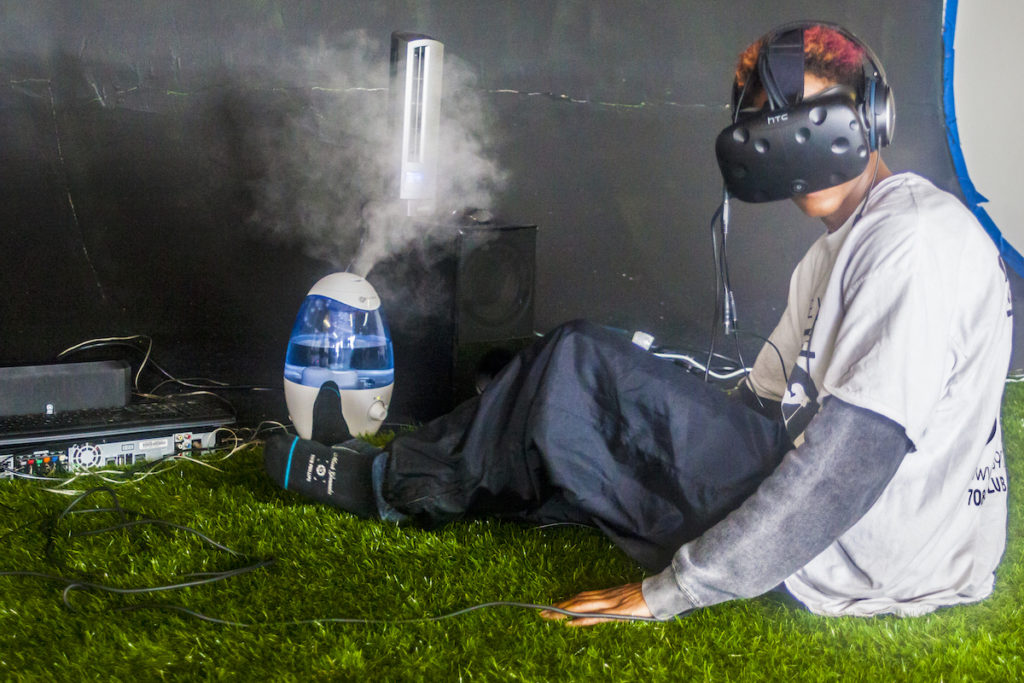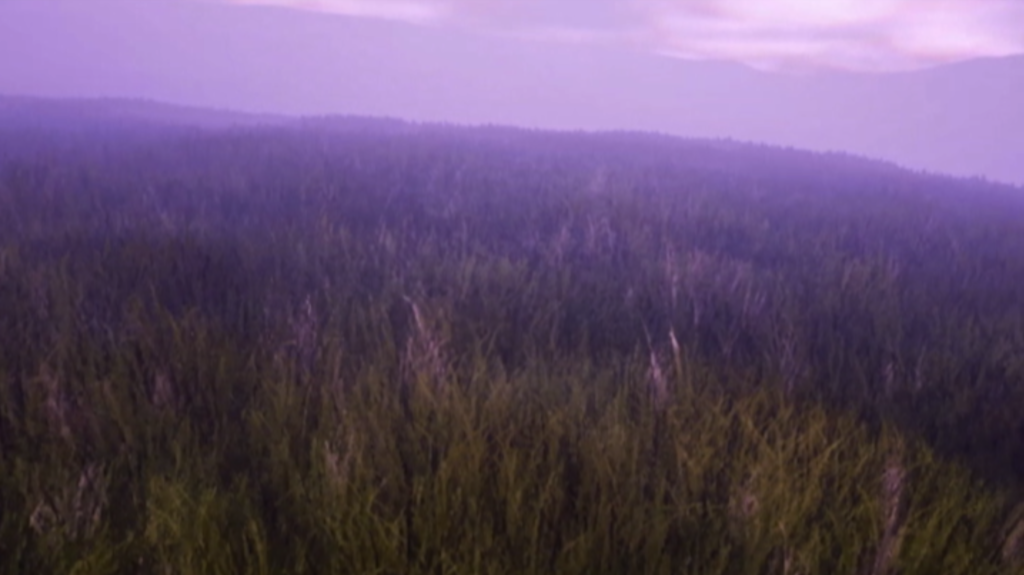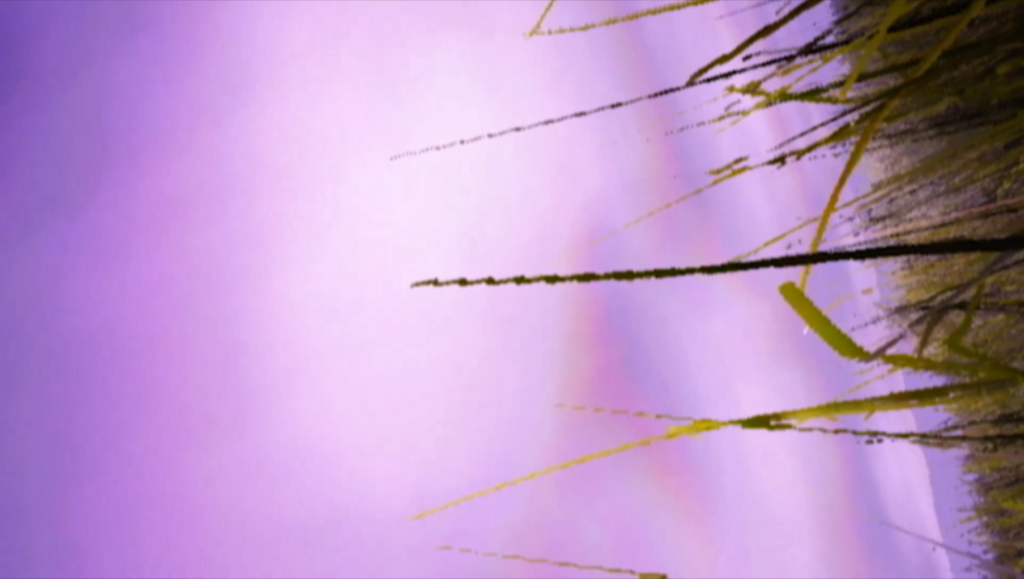Navigating Digital Natures: The Calm Before the Storm
by Patrick Stephenson

In the Summer of 2018 inside of a warehouse in the Garfield Park neighborhood of Chicago, a small exhibition entitled The Calm Before The Storm had quietly taken shape. While located in an artist-run, live/work space, the bulk of the exhibition is not viewable in the physical space, as The Calm, is an experimental simulated environment. According a statement—posted on Instagram—written by The Calm Before The Storm organizers, Sara Law, Christian Oiticica, and Taylor Cleveland, “The abundance of digital media and immersive technology that surround our lives have formed a disassociation with nature.”1 This is the guiding feature of the exhibition, which consists of a dual, physical/virtual reality (VR) installation—a collaborative effort—as well as several of Law’s paintings which haphazardly circle the installation space. One element of the installation which sets it apart from other notable VR works, is the immediate visibility of its technology. Instead of hiding all the computers, wires, tripods, extension cords, and other hardware responsible for bringing the viewer into the VR world—Cleveland, Oiticica, and Law have elected to leave these components in plain sight, stating that, “All of the technology utilized to create The Calm Before The Storm are visible in the installation. It becomes a focal point until a user enters the virtual environment and becomes immersed in the faux landscape.”

The physical installation is rather barebones-looking, due to all of its exposed machinery. To enter the virtual space, however, one must situate themselves on a large rectangle of AstroTurf laid out in front of a black backdrop. Set up along the backdrop is a labyrinth of cords and wires, and even what appears to be some sort of humidifier—which in time, reveals itself as an olfactory feature, gently spritzing a floral-scented mist into the air every few seconds. There is a VR headset and a pair of headphones that sit eagerly on the plasticky grass, waiting to be utilized. After donning the headset and headphones, the viewer has entered ‘The Calm.’ The feeling of The Calm Before The Storm is reminiscent of a sensory deprivation chamber, in the sense that it erases all notions of reality outside of its own technology. Although, rather than completely depriving the viewer of their senses, The Calm acts more simply as a sensory augmentation chamber. Once the user has “submitted themselves to the hardware,” they retain only partial autonomy over their own body; They can still see, hear, feel, and even smell their surroundings but only to the extent that ‘The Calm’ allows. The user cannot stray any further than the AstroTurf square—the texture of which mimics the grass simulation one would see through the headset—due to the length of the cords which tether the user to the simulation’s hardware. After a few initially confusing moments, users are free to explore the virtual landscape, as its limits have now been properly tested.

Inside the headset—after one’s eyes have adjusted to the simulation—there is an otherworldly, magenta sky and rolling hills covered with high definition wild grass that sways loosely in the imaginary wind. A distant thunderstorm makes itself known through the headphones, and every few minutes it syncs up with a crack of lightning—a straight white line against the landscape, hinting at the digital reality of the world. In my own experience with the installation, I became disoriented when I found that the simulation was lacking a virtual body for the user. During past experiences with VR I have participated in immersive video-games in which the computer usually provides a digital dummy to stand in for my own body. In these games, the player’s digital body serves no real purpose other than to ground its physical counterpart in the virtual space, and the decision to withhold this grounding element from The Calm’s digital world strikes me as significant.

While suspended, I could not help but contemplate the sense of separation of mind and body brought on by my lack of a digital vessel, in spite of my ability to utilize all of my senses. This disembodiment of the user speaks to the disassociation between humans and nature outlined in the statement for the exhibition. It would seem initially that this virtual experience of nature is inherently limited, and that while the technology responsible for creating these worlds is remarkable and immersive, it can never accurately reproduce the real thing. However according to the organizers, “The Calm Before The Storm, is a simulated environment mimicking an organic phenomena pushing users further into a hyper reality.” This leads me to believe that the intent was not to fully recreate an authentic natural experience, but rather to push the viewer’s personal disassociation with the natural, while simultaneously using the virtual experience as a tool to restrain, limit, or otherwise control the user’s interaction with the physical space of the installation. To be dropped into a world so close to familiar, yet so far from any non-virtual reality is disconcerting. The landscape is recognizable, yet just a bit too saturated. The scents are familiar, but faint and concentrated to one area. The user has the ability to reach out and feel the grass in front of them, only to be met with a plastic interpretation of the real thing. In my view, this pushes the idea that technological advancement—while convenient and, in many ways a true marker of human innovation—plays an active role in progressing and further enabling not only mankind’s disassociation with nature, but also mankind’s disassociation with our impact on nature.

These ideas are furthered by the exhibition’s layout. The central feature of the room is obviously the installation, however scattered around the space are paintings, made by Law, which—when viewed in tandem with the VR installation—take on an ethereal, almost eerie presence informed by the landscape within the headset. The paintings also enhance the already strange dynamic between any given exhibition visitor and the current VR installation user, given that they are arranged around the installation space, placing the current user of the headset at centerstage, so to speak. While attempting to make one’s way around the rest of the space to view each individual painting, one cannot help but take part in the more voyeuristic aspect of the exhibition, watching the user. This may very well be the most interesting part of the experience, as with any VR experience. Why would anyone not want to watch a friend, family member, or even a stranger wander aimlessly around looking dazed and confused with a computer strapped to their face, reacting to nothing? It is undeniably entertaining, however there is something also a bit off-putting about watching an individual completely succumb to the hardware strapped to their body and lose themselves in the artificiality of the simulation. It is not necessarily a bad feeling, but rather a feeling similar to that which one feels while watching a storm slowly close in on the horizon, something deeply unsettling, but also immeasurably exciting.
The Calm Before The Storm ran at the Albany-Carroll Arts Building, June 2018.